
Thank you for visiting HOJO website. If you have any enquiry, please feel free to get in touch with us at
▼ Akira Hojo
▼ Hojo Newsletter
▼ HOJO FACEBOOK





HOME > Green Tea > Hon Yama Sencha
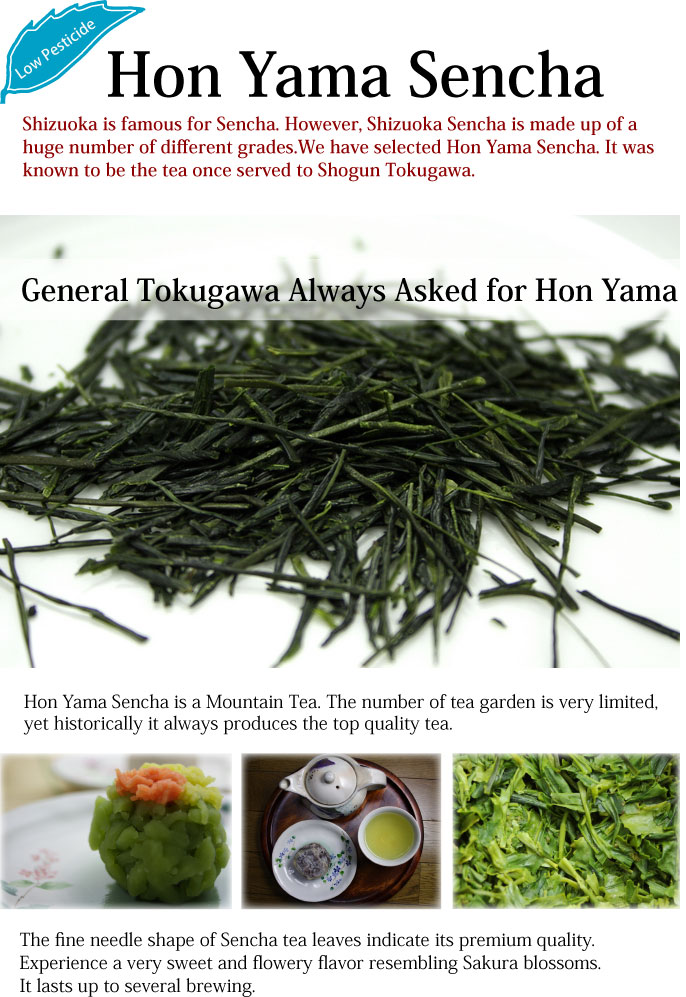

Shizuoka Hon Yama which is well-known as the Gift Tea to Shogun Tokugawa is suitable for the genuine Japanese tea drinker.
The upstream of Warashina River that is the tributary of Abe River in Shizuoka produces a very thick fog that acts as a natural curtain to tea gardens located on the slopes of the mountain. As a result, tea contains a very high percentage of amino acid and natural sweetness that gives an outstanding aroma, umami, mellow taste and sakura-like flavor lingering after-taste.
We emphasize on the original taste of Hon Yama Sencha, therefore we do not conduct any blending but stick to the single origin of Hon Yama tea.
The strength of Hon Yama tea not only comes from its quality that you will experience but also from the management of pesticide usage at each tea garden. With an intensive traceability system, we are able to trace the farmer, garden, the type of pesticide, and the concentration used at fixed periods. With this system, Hon Yama Sencha is managed at a very low pesticide usage. The co-existence of traditional and advance pesticide control system gives reliability to Hon Yama tea.
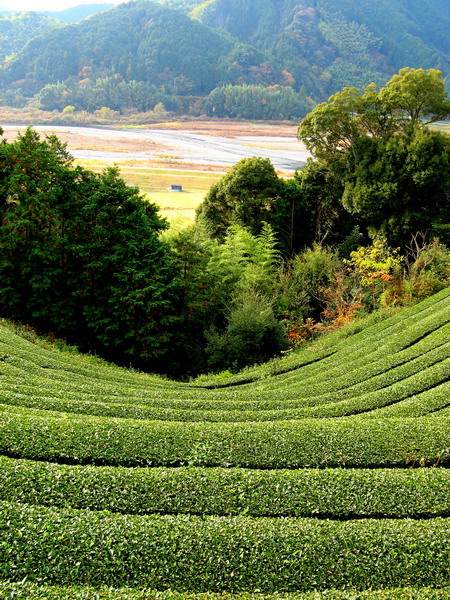

Hon Yama is located deep inside Shizuoka city.The name of Hon Yama is used for the tea grown along the Abe River or Warashina River stream. Abe River is one of the steep and clear-water rivers in Japan. There are a number of slope along the river side. This place is covered by fog and the daytime is short that limits the growing speed of tea and makes flavor and taste of tea thicker.
The literature (東福寺志) stated that the first tea bush was seeded by a monk during Kamakura era (year 1244). According to the oldest record of Japanese tea written in 1211 by a monk named Ei Sai (栄西), Hon Yama tea was one of the oldest teas in Japan.
The fame of Hon Yama tea reached the climax thanks to Shogun Tokugawa Ieyasu who founded the Edo Era. According to the records, the Shogun Tokugawa constructed the tea store deep inside the mountain at the upstream of Abe River in order to maintain the quality of his tea.
The tea produced along the Abe River was usually meant for the high-end market in Japan. In order to differentiate their quality from ordinary green tea, the name Hon Yama was given as a brand to represent its premium quality.
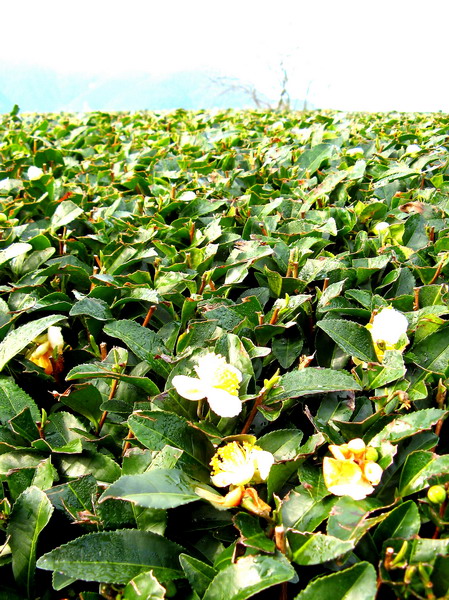

One of the quality criteria of Japanese green tea is its sweetness. It is amino acid called theanine. The young bud is rich in theanine. When the tea leaves absorb sunshine, theanine is biologically converted into polyphenol such as catechins, which gives a bitter taste. The tea garden of Hon Yama which is distributed along the Abe River banks, is located on the slopes of a mountain, approximately from mid-mountain to the upper area. The river constantly produces a very thick fog which covers the tea garden and blocks out the sunshine. Without sunshine, the bio-conversion of theanine to polyphenol is slowed down. Therefore, Hon Yama tea contains a very high percentage of theanine.
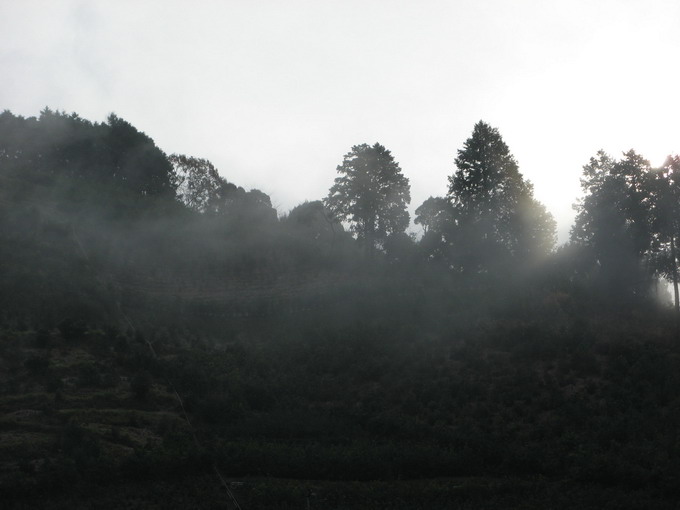
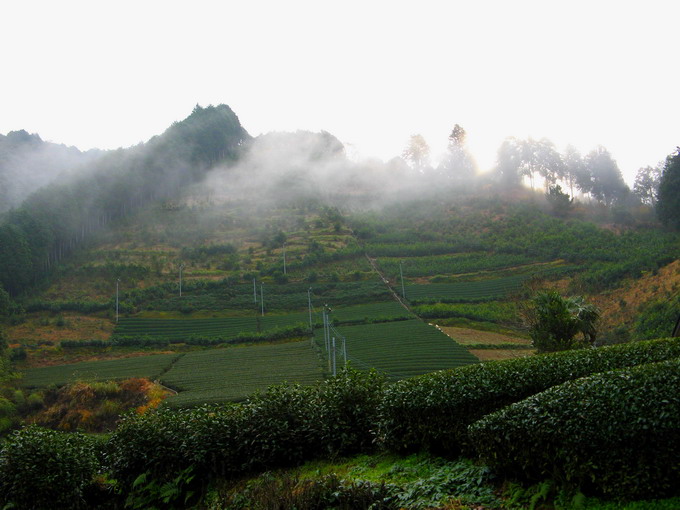
Polyphenol is the substance which gives bitterness and astringency. Although some people may prefer the bitter taste of green tea, the high-end Japanese green tea is supposed to be sweet. Thanks to the geographical factors, Hon Yama area always produces tea leaves that contain a high percentage of theanine. Hojo particularly selects the tea from the Warashina River slopes which is located deep inside the Abe River and selects tea from the tea garden up on the mountain slopes.
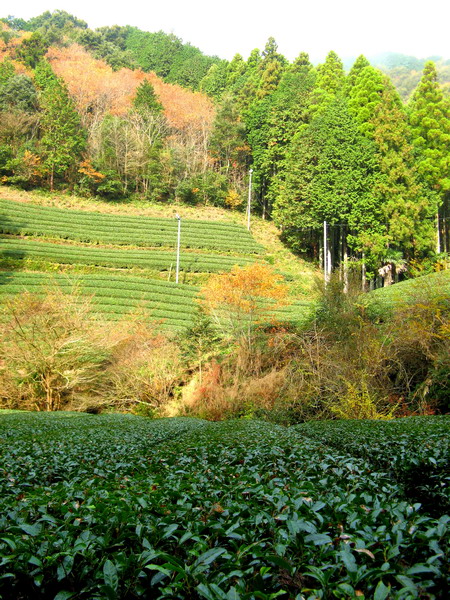
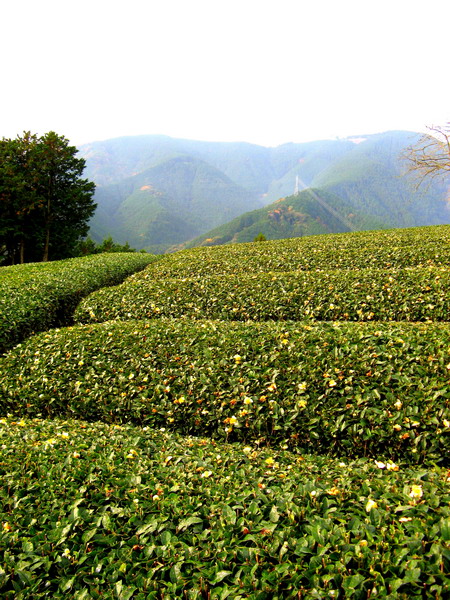
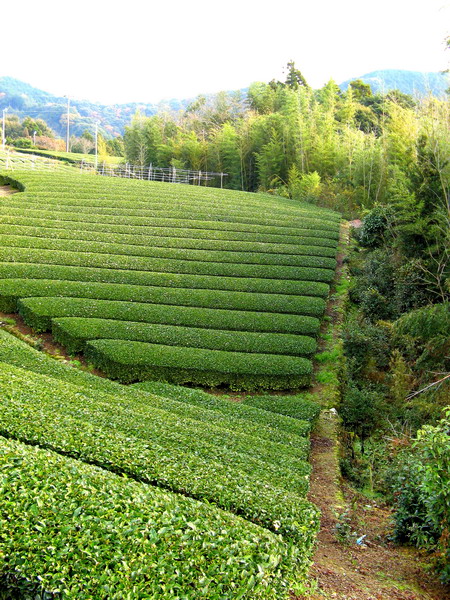
Hon Yama tea is produced from Yabukita. Starting from end of April until beginning of May, first flush is plucked based on the criteria; one bud and two leaves. Hojo selects the first flush particularly the early batch. The reason is that, soon after this period, the raining season starts and tea plants grow very fast, which will cause the taste of tea to become thin.
Plucking is conducted after the sunrise in order to avoid the morning dew. Contamination of morning dew will cause partial over-heating during the steaming process that destroy the tissues of tea leaves and affects the quality. Therefore, good Sencha must be produced from tea leaves plucked during a sunny day.
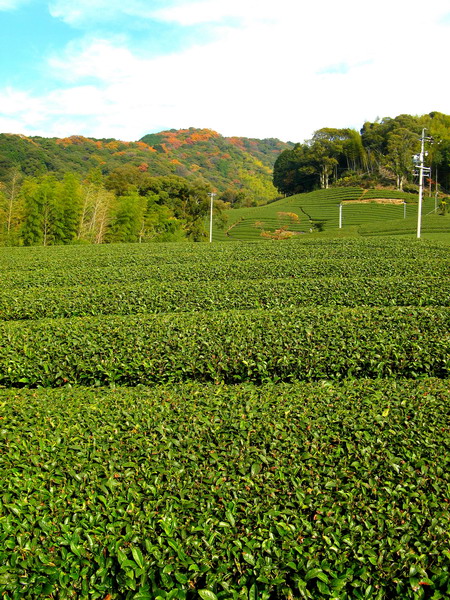
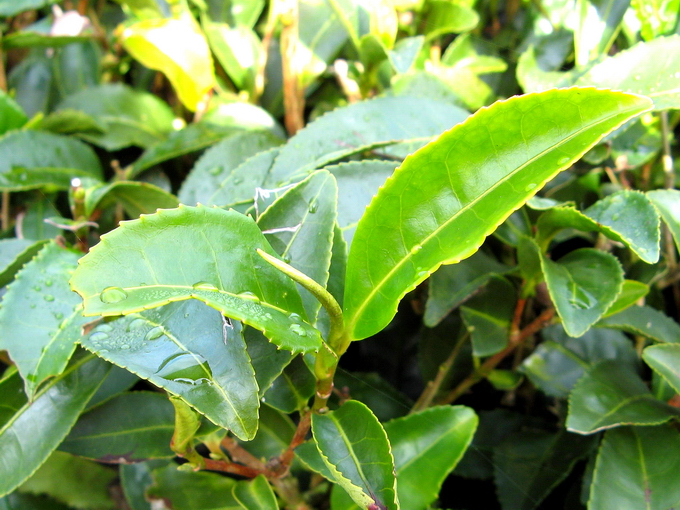
Tea leaves plucked from different tea gardens are segregated. Different tea gardens carry different lot numbers and will not be mixed in order to establish their the clear traceability.
The quality of Sencha is depending on the steaming process. In order to bring out the identical character of Hon Yama tea, the steaming process is conducted at a very short time of about 30 seconds. Applying the high temperature steam for a short time, will result the tea leaves to become very dry and it will not be moistened by condensation. This is one of the key points to produce good quality teas.
Tea leaves have to be quickly cooled down and at the same time evaporate the moisture. Immediate reduction of the wet heat is very important to avoid secondary heating of tea leaves.
Effectively dries by agitating the tea leaves under the hot air. At the same time, the mixing will soften the leaves.
This is the only process conducted without heat. The machine moves in circular motion with pressure that spread the moisture of tea leaves evenly. The tea leaves generates heat due to the friction. Therefore, at regular intervals it is necessary to loosen the tea leaves and release the heat.
A rotary dryer is used, gently rolling the tea leaves and conducts the drying, reducing the moisture, and twist the tea leaves into a finer shape.
It is the reciprocal movement of back and forth, combined with circular motion, twisting the tea leaves into a needle shape. High quality Sencha appears to be dark green in color, shinny and solid.
After the final rolling, the tea leaves still contain moisture. Drying will reduce moisture until 5%. These leaves are called Aracha (crude tea). Aracha has not undergone the firing process. Compared with the finished tea product, the flavor of fresh leaves and bitterness is very strong.
Each tea wholesaler purchase Aracha as raw material, and based on their individual process, they will conduct firing. This is how they create their original quality. Subsequently, they will blend a few kinds of tea and create a wholesaler’s original brand.
As for Hojo’s Hon Yama tea, we emphasize on the traditional taste and flavor of Hon Yama. The firing process is carried out by a technician who lives in Hon Yama based on their traditional method and process into the actual Hon Yama taste. In particular, we conduct very short firing process in order to enhance the delicate greenish fragrance of Hon Yama tea.
The taste of Sencha consists of bitterness, astringency, sweetness (umami) and total balance. Each taste is reflected by different types of substance. Therefore, depending on the brewing method, the taste-balance is influenced and the result in totally a different taste. We suggest that everyone should learn the standard method, and after understanding it, develop your own method and enjoy your cup of tea.
In you are using tap water, it is necessary to filter the water using an activated carbon filter. If not, you wouldn’t be able to enjoy the authentic taste of tea. Chlorine is added to tap water in order to sanitize bacteria. This chlorinated water will also harm our body cells. Concerning about our health condition, it is very important to remove chlorine from drinking water. The most effective method in removing chlorine is to install an activated carbon filter. This type of filter is designed for removing organic substance. It will remove not only chlorine, but also other harmful substance such as contaminated pesticide. The activated carbon filter can be easily obtained from the common hardware shop in most countries. If activated carbon filter is not available, please place a charcoal inside the water and leave it for over night. The material composed of activated carbon filter is made of ground charcoal. The difference is that activated carbon filter contains much finer particles and hence it has extremely large surface area for a better efficiency in filtration. We do not suggest RO water (reversed osmosis water) or distilled water. This water carries no mineral, the taste and flavor of tea tends to be very unstable, unless you have very superior quality tea and tea equipment.
In the long run, you may observe a thick layer of scale accumulated inside your kettle. Our mother usually taught us to wash and remove it with citric acid. But please do not even try to remove the scale. Scale consists of minerals that exist in the water. The mineral composition is reflected from the water you used. If you remove the scale, the mineral ion balance between scale and water is destroyed. This balance is called buffer effect in science. The flavor and taste will seriously run out and you won’t be able to get previous taste and flavor for a long time. It is also important to stick to the same type of water whenever brewing tea. If source of water is changed, it carries different type of minerals. It will affect the mineral ion balance too.
Go to further information about suitable water for brewing tea >>
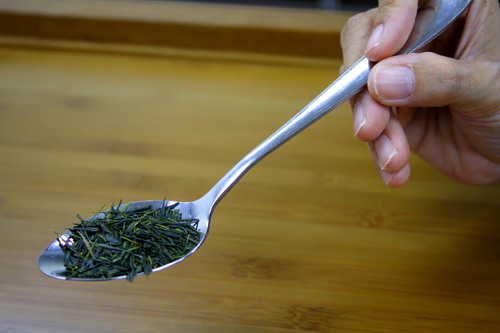
Usually divide volume of hot water by 50 in order to calculate the weight of tea leaf. For example: The volume of teapot = 200ml; 200ml/50 =4g. You need to measure 4g of tea leaf for 200ml of water.
It is important not to use boiling water. Boiling water should be poured into an empty glass or any container, let it cool down until you can hold the glass by hand for 5 seconds. Usually the temperature is relatively higher for Deep Steamed
Sencha at around 75-80 degree, 60-70 degree for Sencha and 45-60 degree for Gyokuro. For second brewing onwards,
gradually increase temperature by step-wise. Most importantly, do not jump up to boiling temperature. The more steps
you have before reaching to boiling temperature, the more number of brewing you can enjoy.
Pour the hot water into the tea pot, and brew for 1 minutes.For the second and third brewing, please stick to the temperature that is as low as the first brewing. Brewing time for 2nd and 3rd brewing is as short as 2-3 seconds. The forth and fifth brewing, please increase water temperature +10 degree C or increase brewing time another 10 seconds. The sixth brewing onward, please progressively increase brewing temperature in order to maintain the thickness of tea. At last, you can use boiling water to brew tea.
If use boiling water to brew Japanese Green Tea, all kinds of substance rush into the first cup, that will be extremely bitter. In addition, you won't be able to enjoy brewing tea up to 7 times as most of tastes are lost on first brewing.
It is advisable to use a clay tea pot as it improves the taste. Hojo recommends either purple clay or red clay. Purple clay makes flavor very strong, while aroma is a little weak. Red clay keep aroma but flavor is not as strong as being brewed by purple clay.
Traditionally, the Japanese never use a pitcher. The tea is directly poured from the tea pot into respective tea cups. In order to make the concentration evenly, we have to pour one cup after another, repeating a few times until the last drop of tea. The purpose of pouring until the last drop is to extract the concentrated liquor. This is important as tea leaves must be filtered well and kept without water to avoid the liquor becoming bitter and stewed. Besides, it prevents tea leaves from being over cooked. In addition, filtration will make it ready for the second brewing.
After pouring the tea, you have to leave the lid open to avoid further steaming of tea leaves.
Brewing tea at high temperature will give a bitterness and astringency while will overtake the sweetness which is the character of this tea. Therefore, brewing at lower temperature for longer time is important. However, if you prefer very hot and bitter taste, brewing at 90?C for 30 seconds is one of the ways, but controlling the timing is rather difficult and practice is necessary.
Most of Green Teas can be brewed in cold water. The better quality of tea will gives nicer taste both in cold and hot water brewing.
1. Measure 1 table spoons of tea leaves for 500ml of water.
2. Pour in water and leave it for more than 1 hour.
3. Stir the container in order to even out its concentration.
4. Usually the taste of tea is getting thicker when it is brewed for more than a few hours. In this case,
5. Top up additional water. Eventually tea can be brewed more than 1 liters per 1 table spoons.
The benefit of cold water brewing is Tea can last for whole day and the taste is natural sweet and refreshing. Thanks to the cold water extraction, the level of caffeine in tea is extremely low. You would not suffer from sleepless night. It can be
even enjoyed by kids.
Once a bag of tea is opened, please finish it within 3 months if you wish to enjoy its freshness. From the medical point of view, it is safe to consume the tea even if it is kept for a few years. However the freshness disappears if it is kept for too long. Tea must be tightly sealed before it is kept. Tea should be kept in ambient and dry conditions such as in the living room, but it must be completely away from humidity. Tea should not be kept in the kitchen as the environment is very humid. Avoid enclosed area such as inside the cupboard or drawer as these places are damp. Also avoid opening the bag of tea in humid atmosphere. It is recommended to open the bag during a sunny day or under air-conditioned atmosphere. Once tea leaves absorb moisture, deterioration of tea will be triggered within a few days. Tea will then give an astringent taste, sometime it tastes sour. The fresh aroma also becomes weaker.
The quality of tea lasts longer if it is kept in the fridge. However we strongly recommend you not to keep tea in the fridge. When tea is withdrawn from the fridge, there is usually condensation. Once tea is exposed to moisture during condensation, the quality will deteriorate within a few days. The higher moisture content in the tea leaves will trigger oxidation and it will completely destroy the quality of tea.
Here’s one frequently asked question: what happens if bag is sealed using tape or tea is packed in zipper bag and kept inside the fridge?
For your information, these simple sealing methods are not sufficient. When the bag is withdrawn from the fridge, it is cold inside the bag and therefore causes negative pressure. Air will be drawn from outside and condensation will occur. In addition, if the bag is taken in and out from the fridge very often, this will cause heat stress to the tea leaves as temperature is increased and decreased very frequently. If tea is kept in the fridge, when it is withdrawn from the fridge, it is necessary to leave it in ambient atmosphere for more than 24 hours in order to warm up the tea leaves. Based on our experience, 12 hours is not long enough. We may think tea is warmed up, but inside the bag, the tea leaves are still cold due to insulation effect.

Please feel free to send us e-mail for enquiry at:

 |
We accept various kinds of credit card through Paypal.
Only if customer prefer other option of payment, we suggest "Bank Transfer".
Various choice of shiping method
EMS, SAL, Small Packet, Small Packet (SAL) Yamato Express and Surface
For shipping tea, we usually suggest small air parcel, the estimated shipping cost of tea in 100g (with wrapping material ) is
Small Parcel
USA JPY 600, EU JPY600 and Asia JPY470
Small Packet (SAL)
USA JPY380, EU JPY380 and Asia JPY320
The shipping fee to oversea by small air parcel happens to be even cheaper than domestic shipping fee in Japan.
For your information, some countries, EU in particular imposes custom duty. We need buyer to bare the duty. We are sorry, but we cannot change the amount on the invoice, and we do not mark any packages as gifts. We will strictly follow the custom regulation.